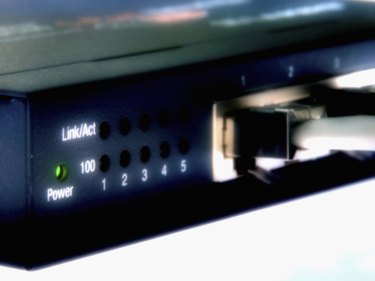
Cable modems offer a great way to get fast Internet to your home or business. If you have two different modems, they can be combined in a variety of ways to achieve different results, from managing your bandwidth more efficiently to providing improved speeds or access to multiple devices. These devices can be connected to a single Internet account or can double your bandwidth if you provide them each their own Internet account from your Internet service provider.
Bridging
Video of the Day
If you only have one Internet connection but two modems, you can connect the pair by putting one modem into bridge mode and physically connecting them through an Ethernet cable. This allows the modem to act as a router to share your Internet connection and is useful if you want to have two separate network groups in your home or office. However, many routers offer the same set of bridge features for a lower cost and often provide better bandwidth usage and speeds.
Video of the Day
IP Settings
You have to adjust settings on your modems in order to connect them. Connect your primary modem to the Internet and your PC. Find and write down the modem's IP address and subnet mask. Connect your PC to the other modem and turn off its "DHCP Server" settings, sometimes listed as enabling "Bridge" mode. Select its static IP option and input an IP address that is the same as your primary router's IP, except change the final number. In the subnet mask boxes, enter the same number as your primary router with no changes.
Physical Connections
Make sure your primary modem is connected to the Internet and plug an Ethernet cable into one of its LAN ports. If you want devices on each network to speak to each other, connect the other end of this cable to the LAN port on your secondary modem. If you just want to share the Internet connection and have separation between networked devices, plug the end of the cable into a WAN port on your secondary modem.
Load Balancing
Load balancing is one of the more popular features of a two-modem setup if you also have two Internet connections. Using a dual WAN router, also called a load balancing router, hook up both cable modems to the router to divide your Internet traffic equally among the two Internet connections. This means high Internet usage by one device will not slow down the others and your devices will stay connected to the Internet even if one of the Internet connections goes offline.
- Vicomsoft Learning Center: Bandwidth Aggregation, Bonding and Teaming
- Cisco: Configuring Cable Modem Bridging
- SamKnows: Bridge FAQ & Installation
- EZLAN.net: Combining two Internet Connections
- Cisco: How Does Load Balancing Work?
- BroadbandInfo.com: Cable Modem Tweaks to Improve Your Internet Connection Speed
- Diffen: LAN vs WAN